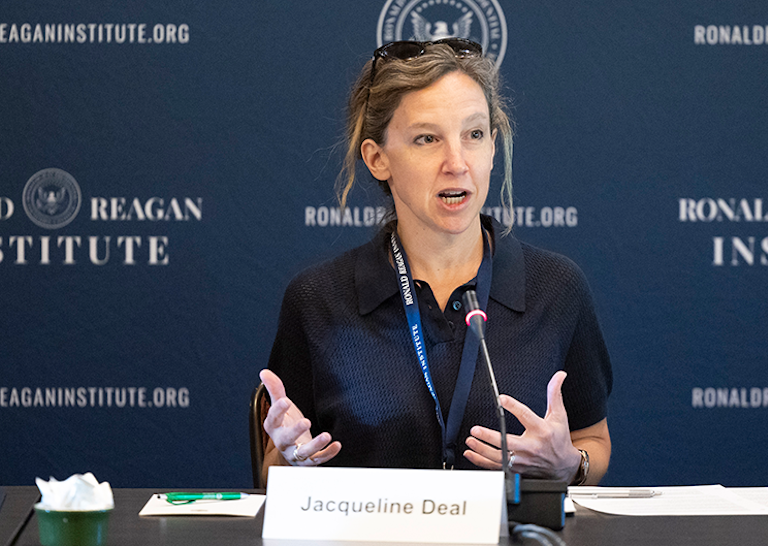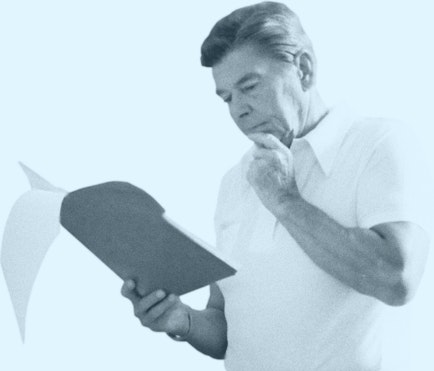Ronald Reagan Institute
Balance in the Indo-Pacific: Defining the U.S. Approach | A Response from Jacqueline Deal
By Jacqueline Deal

A Response from Jacqueline Deal
Alex Wong’s “balance” strategy for the United States in the Indo-Pacific is comforting, concise, and clearly communicable to domestic and foreign audiences. It proceeds logically from U.S. goals: The United States does not seek hegemony. We just need continued economic access and peace—i.e., to avoid being excluded from regional markets and to prevent the outbreak of a war that could go global. The United States can achieve these objectives by becoming “indispensable to both reducing risk and enhancing rewards for all involved,” Wong writes. He then offers a set of diplomatic, military, and trade principles to guide our pursuit of this status.
Unfortunately, these principles may not suffice. Below I summarize troubling trends in the region and world that explain why more may be required and then outline potential additions to the strategy to improve its chances of success. The main addition is an informational or political warfare line of effort.
Troubling Trends
Arguably, the United States played an indispensable role in the Indo-Pacific, and beyond, from World War II through the end of the Cold War. (The late Madeleine Albright called the United States “the indispensable nation” for this reason.) American economic support enabled the rise of the export-driven East Asian tiger economies, while American military power secured seaborne trade routes and deterred major-power conflict in the region. But we are now approaching—or have reached—the limits of our ability to play this role. In Wong’s words, balance will be achieved “if the United States becomes indispensable…” The “again” at the end of the sentence is omitted but implied.
What accounts for the erosion of the American position in the region? The U.S. share of global gross domestic product (GDP) declined from 50 percent after World War II to less than 20 percent today. In the meantime, over the last several decades, the Chinese Communist Party (CCP) regime that Wong accurately identifies as not just seeking but needing dominance has achieved remarkable gains. China has become the world’s second-biggest economy and the largest trading state. Many of the United States’ closest allies trade more with China than they do with the United States, and China is now the largest trade partner of more countries than the United States.
How did this happen? The United States was so far ahead of the rest of the world in the post-World War II era that we could afford both to subsidize and to protect democratic allies to promote prosperity and to preserve peace. Starting in the late 1970s, we extended a measure of this largesse to the People’s Republic of China (PRC). China became an ally against the Soviet Union, so the policy made sense at the time.
After the end of the Cold War, however, we not only continued to support Chinese economic growth but expanded and deepened the connection. American consumers benefited from access to cheap Chinese goods, but many workers lost their manufacturing jobs. U.S. firms benefited from access to low-cost Chinese labor, but the engagement cost them technology and, ultimately, market share domestically and in the rest of the world, which also welcomed cheap Chinese products.
Meanwhile, China’s economic and technological rise has reinforced the security of the increasingly totalitarian CCP. The party has been harnessing vast troves of domestic and foreign data to increase its wealth and power. This poses a threat to the free world, starting with Taiwan, in peace and in war. By one estimate, the value of Chinese military procurement is likely to exceed that of the U.S. military during President Biden’s administration.
These trends set the context within which Wong’s strategy will operate. In the economic domain, Wong proposes that we increase the rewards to Indo-Pacific partners by pursuing trade and investment agreements that focus “on a sectoral basis in energy or in strategic industries, like semiconductors, key minerals, or pharmaceuticals, where there are mutual needs to diversify supply chains away from China.” We can thus harness “the weight and productive power of our private industry and capital.”
This is worth pursuing, though China is unfortunately likely to retain access to the system of trade and investment within which the proposed new agreements will be nested, and Beijing has proven its ability to evade or defy efforts to foreclose its access to sensitive technologies and critical industries. The biggest obstacle is that in most cases we will be asking countries to bear short- to medium-term costs to move away from Chinese trade partners, and in light of the GDP trends mentioned above, we are not in a position to offset these expenses across the board.
On the military side, Wong recommends that the United States reduce the risk to Indo-Pacific partners by making “new investments in strategic nuclear forces, intermediate-range missiles, our naval fleet, and certain capabilities tuned to turning back an invasion of Taiwan.” Concurrently, we should deepen our alliances with Japan, Australia, and the United Kingdom, and work with India while respecting its non-aligned culture to promote its progress toward being a “full-spectrum [i.e., not exclusively military] balancer” of China. This guidance makes sense, but it may not be enough considering the pace at which the People’s Liberation Army (PLA) is modernizing. Unfortunately, the pace appears to be increasing, as if Beijing perceives a window of opportunity.
Additional Elements to Consider
Troubling trends and accelerating Chinese assertiveness may require the United States to assume risk to achieve outsized rewards. The below elements are therefore proposed as higher-leverage options that could amplify or reinforce Wong’s principles.
Defense
In addition to new investments in the areas Wong mentions (nuclear weapons, missiles, and naval ships), the United States could prioritize areas where the PLA is not already outpacing our defense spending. Space would seem to be such an area, as the United States may retain historical advantages or be acquiring new ones due to the commercialization of launch technology. The PRC may be especially sensitive to U.S. aerospace capabilities that enable penetration of its territory.
The United States also retains a lead in the long-range strike competition. Though the PLA is building new bombers and nuclear submarines, we still have more ways to target the mainland than the PRC has to target the continental United States. How can we exploit or grow this advantage?
Trade
Up to now, China has benefited disproportionately from its access to the markets of free societies. How can the United States and its allies and partners reverse this trend?
How can the United States induce or incentivize its allies and partners to bear costs to reduce their dependence on China for critical materials and to expel China from sensitive supply chains?
Information Campaign
To achieve these trade objectives, an informational campaign is likely necessary. Both the American population and the democratic publics of our allies and partners need to know more about what is at stake in the competition with China. This will help make the case for the near-term belt-tightening required to wean ourselves from a dangerous interdependence.
Using our commercial access to China to shine a light on the CCP’s activities at home and abroad would likely enhance our competitive position. The more we impose transparency on the Party, the more we put it on the horns of a dilemma about whether to retain its engagement or close itself off from the world. This stress would also be likely to intensify debates among CCP elites, while making it more difficult for apologists in the West to make the case for continued business as usual with Beijing.
The China Dream in the Balance
Wong states that his balance strategy is not “China-focused.” I agree on the importance of emphasizing outreach to regional allies, partners, and friends rather than to Beijing. I also think Wong would agree that his strategy is China-driven—i.e., we would not need it if Xi Jinping were not accelerating the efforts of his CCP predecessors to achieve what he calls the “China Dream.” Accordingly, this response has highlighted potential areas to backstop balance and resurrect American indispensability tailored to the particular character of the China challenge.
Join Our Newsletter
Never miss an update.
Get the latest news, events, publications, and more from the Reagan Institute delivered right to your inbox.
